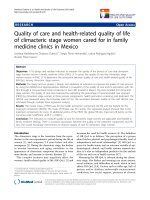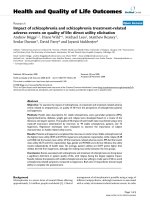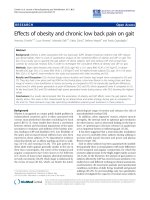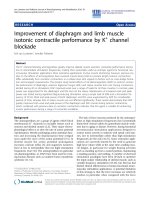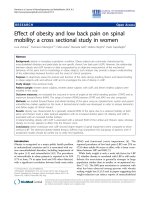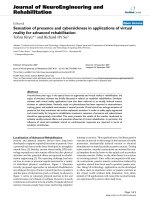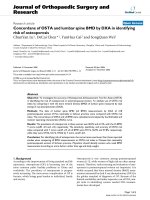Báo cáo hóa học: "EXTENSIONS OF THE RESULTS ON POWERS OF p-HYPONORMAL AND log-HYPONORMAL OPERATORS" ppt
Bạn đang xem bản rút gọn của tài liệu. Xem và tải ngay bản đầy đủ của tài liệu tại đây (549.52 KB, 14 trang )
EXTENSIONS OF THE RESULTS ON POWERS OF
p-HYPONORMAL AND log-HYPONORMAL OPERATORS
CHANGSEN YANG AND JIANGTAO YUAN
Received 22 November 2004; Revise d 27 April 2005; Accepted 10 May 2005
Firstly, we will show the following extension of the results on powers of p-hyponormal
and log-hyponormal operators: let n and m be positive integers, if T is p-hyponormal for
p
∈ (0,2], then: (i) in case m ≥ p,(T
n+m
∗
T
n+m
)
(n+p)/(n+m)
≥ (T
n
∗
T
n
)
(n+p)/n
and
(T
n
T
n
∗
)
(n+p)/n
≥ (T
n+m
T
n+m
∗
)
(n+p)/(n+m)
hold, (ii) in case m<p, T
n+m
∗
T
n+m
≥
(T
n
∗
T
n
)
(n+m)/n
and (T
n
T
n
∗
)
(n+m)/n
≥ T
n+m
T
n+m
∗
hold. Secondly, we will show an estima-
tion on powers of p-hyponormal operators for p>0 which implies the best p ossibility
of our results. Lastly, we will show a parallel estimation on powers of log-hyponormal
operators as follows: let α>1, then the following hold for each positive integer n and m:
(i) there exists a log-hyponorm al operator T such that (T
n+m
∗
T
n+m
)
nα/(n+m)
≥ (T
n
∗
T
n
)
α
,
(ii) there exists a log-hyponormal operator T such that (T
n
T
n
∗
)
α
≥ (T
n+m
T
n+m
∗
)
nα/(n+m)
.
Copyright © 2006 C. Yang and J. Yuan. This is an open access article distributed under
the Creative Commons Attribution License, which permits unrestricted use, distribution,
and reproduction in any medium, provided the or iginal work is properly cited.
1. Introduction
In this paper, let H be a complex Hilbert space and B(H) be the algebra of all bounded
linear operators in H, and a capital letter mean an element of B(H). An operator T is said
to be positive (in symbol: T
≥ 0) if (Tx,x) ≥ 0foranyx ∈ H, and an operator T is said to
be strictly positive (in symbol: T>0) if T is positive and invert ible.
An operator T is said to be p-hyponormal for p>0if(T
∗
T)
p
≥ (TT
∗
)
p
,whereT
∗
is the adjoint operator of T.AninvertibleoperatorT is said to be log-hyponormal if
log(T
∗
T) ≥ log(TT
∗
). If p = 1, T is called hyponormal and if p = 1/2, T is called semi-
hyponormal. It is clear that every p-hyponormal operator is q-hyponormal for 0 <q
≤ p
by the celebrated L
¨
owner-Heinz theorem and every invertible p-hyponormal operator for
p>0 is log-hyponormal since logt is an operator monotone function. log-hyponormality
is sometimes regarded as 0-hyponormal since (X
p
− 1)/p→ logX as p → 0forX>0.
Recently, Furuta-Yanagida [6] showed the following results on powers of p-hyponor-
mal operators with p
∈ (0, 1] which is a generalization of Aluthge-Wang [1].
Hindawi Publishing Corporation
Journal of Inequalities and Applications
Volume 2006, Article ID 36919, Pages 1–14
DOI 10.1155/JIA/2006/36919
2Powersofp- and log-hyponormal operators
Theorem 1.1 [6]. Let T be a p-hyponormal operator for p
∈ (0, 1]. The n
T
n
∗
T
n
(p+1)/n
≥···≥
T
2
∗
T
2
(p+1)/2
≥
T
∗
T
p+1
,
TT
∗
p+1
≥
T
2
T
2
∗
(p+1)/2
≥···≥
T
n
T
n
∗
(p+1)/n
(1.1)
hold for all positive integer n.
Very recently, Ito [8] showed that Theorem 1.1 holds for p>0.
Theorem 1.2 [8]. If T is p-hyponormal for p
∈ (k − 1,k] where k is a positive integer, then
T
1+m
∗
T
1+m
(1+p)/(1+m)
≥
T
∗
T
1+p
,
TT
∗
1+p
≥
T
1+m
T
1+m
∗
(1+p)/(1+m)
(1.2)
hold for all positive integer m such that m
≥ p,
T
1+m
∗
T
1+m
≥
T
∗
T
1+m
,
TT
∗
1+m
≥ T
1+m
T
1+m
∗
(1.3)
hold for all positive integer m such that m<p.
Yamazaki [13] also showed the following Theorem 1.3 which is a parallel result to
Theorems 1.1 and 1.2.
Theorem 1.3 [13]. If T is log-hyponormal, then
T
n+1
∗
T
n+1
n/( n+1)
≥ T
n
∗
T
n
, T
n
T
n
∗
≥
T
n+1
T
n+1
∗
n/( n+1)
(1.4)
hold for all positive integer n.
We can rewrite Theorem 1.3 into the following easily.
Theorem 1.4. If T is log- hyponormal, then
T
n+m
∗
T
n+m
n/( n+m)
≥ T
n
∗
T
n
, T
n
T
n
∗
≥
T
n+m
T
n+m
∗
n/( n+m)
(1.5)
hold for all positive integer n and m.
In fact, if m>1, then by Theorem 1.3 we have
T
n+m
2(n+m−1)/(n+m)
≥
T
n+m−1
2
, ,
T
n+2
2(n+1)/(n+2)
≥
T
n+1
2
,
T
n+1
2n/(n+1)
≥
T
n
2
,
T
n
∗
2
≥
T
n+1
∗
2n/(n+1)
,
T
n+1
∗
2
≥
T
n+2
∗
2(n+1)/(n+2)
, ,
T
n+m−1
∗
2
≥
T
n+m
∗
2(n+m−1)/(n+m)
,
(1.6)
C. Yang and J. Yuan 3
so that
T
n+m
∗
T
n+m
n/( n+m)
≥
T
n+m−1
∗
T
n+m−1
n/( n+m−1)
≥···≥
T
n+1
∗
T
n+1
n/( n+1)
≥ T
n
∗
T
n
,
T
n
T
n
∗
≥
T
n+1
T
n+1
∗
n/( n+1)
≥···≥
T
n+m−1
T
n+m−1
∗
n/( n+m−1)
≥
T
n+m
T
n+m
∗
n/( n+m)
(1.7)
hold by L
¨
owner-Heinz inequality.
In this paper, we will show Theorem 2.1,theparallelresulttoTheorem 1.4,stated
below which is an extension of Theorems 1.1 and 1.2. We will also show an estimation
on powers of p-hyponormal operators for p>0 which implies the best possibility of
Theorem 2.1 and discuss the best possibility of Theorem 1.4.
2. An extension of Theorems 1.1 and 1.2
Theorem 2.1. If T is p-hyponormal for p
∈ (k − 1,k] where k is a positive intege r, then
(i) in case k
= 1, 2,
T
n+m
∗
T
n+m
(n+p)/(n+m)
≥
T
n
∗
T
n
(n+p)/n
, (2.1)
T
n
T
n
∗
(n+p)/n
≥
T
n+m
T
n+m
∗
(n+p)/(n+m)
(2.2)
hold for all positive integer n and m such that m
≥ p;
(ii) in case k
= 2, 3,
T
n+m
∗
T
n+m
≥
T
n
∗
T
n
(n+m)/n
, (2.3)
T
n
T
n
∗
(n+m)/n
≥ T
n+m
T
n+m
∗
(2.4)
hold for all positive integer n and m such that m<p.
Corollar y 2.2. Let n and m be positive integers, if T is p-hyponormal for p
∈ (k − 1,k],
then
(i) in case k
= 1, 2 and m ≥ p,
T
n+m
∗
T
n+m
(n+p)/(n+m)
≥···≥
T
n+k
∗
T
n+k
(n+p)/(n+k)
≥
T
n
∗
T
n
(n+p)/n
, (2.5)
T
n
T
n
∗
(n+p)/n
≥
T
n+k
∗
T
n+k
(n+p)/(n+k)
≥···≥
T
n+m
T
n+m
∗
(n+p)/(n+m)
; (2.6)
(ii) in case k
= 3,
T
n+2
∗
T
n+2
(n+1)/(n+2)
≥ T
n+1
∗
T
n+1
≥
T
n
∗
T
n
(n+1)/n
, (2.7)
T
n
T
n
∗
(n+1)/n
≥ T
n+1
T
n+1
∗
≥
T
n+2
T
n+2
∗
(n+1)/(n+2)
. (2.8)
Remark 2.3. In case p
∈ (0, 1], Theorem 1.1 follows from Corollary 2.2(i) by taking k = 1
and n
= 1.
In case k
= 1, 2,3 and p ∈ (k − 1,k], Theorem 1.2 follows from Theorem 2.1 by taking
n
= 1.
We need the following results to show Theorem 2.1.
4Powersofp- and log-hyponormal operators
(1, 1)
q
= 1
(1 + r)q
= p + r
p
= q
(1, 0)
(0,
−r)
p
q
Figure 2.1 The best possible domain for Furuta inequality.
Theorem 2.4 (Furuta inequality [3] call it FI simply). If A ≥ B ≥ 0, then for each r ≥ 0,
(i)
B
r/2
A
p
B
r/2
1/q
≥
B
r/2
B
p
B
r/2
1/q
, (2.9)
(ii)
A
r/2
A
p
A
r/2
1/q
≥
A
r/2
B
p
A
r/2
1/q
(2.10)
hold for p
≥ 0 and q ≥ 1 with (1 + r)q ≥ p + r.
FI yields the following famous L
¨
owner-Heinz inequality by putting r
= 0 in (i) or (ii)
of FI. It was shown by Tanahashi [11] that the domain drawn for p, q and r in Figure 2.1
is the best possible for FI.
Theorem 2.5 L
¨
owner-Heinz (L
¨
oner-Heinz inequality [7, 10] call it L-H simply). Let 1
≥
α ≥ 0. Then A ≥ B ≥ 0 ⇒ A
α
≥ B
α
.
Lemma 2.6 [5]. Let α
∈ R and X be invertible. Then (X
∗
X)
α
= X
∗
(XX
∗
)
α−1
X holds, espe-
cially in case α
≥ 1 Lemma 2.6 holds without invertibility of X.
Theorem 2.7 [2, 4, 5, 9]. Let A,B
≥ 0 such that A
α
≥ B
α
for α>0.Thenforeachq ≥ 0 and
t
≥ 0 the following hold.
(1) f
t,q
(s) =
A
t/2
B
s
A
t/2
(q+t)/(s+t)
is decreasing for s ≥ q ≥ 0.
(2) g
t,q
(s) =
B
t/2
A
s
B
t/2
(q+t)/(s+t)
is increasing for s ≥ q ≥ 0.
Theorem 2.8 [13]. Let T be a p-hyponormal operator for p
∈ (0, 1]. The n
T
n
∗
T
n
1/n
≥···≥
T
2
∗
T
2
1/2
≥ T
∗
T,
TT
∗
≥
T
2
T
2
∗
1/2
≥···≥
T
n
T
n
∗
1/n
(2.11)
hold for all positive integer n.
C. Yang and J. Yuan 5
Lemma 2.9. If T is p-hyponormal for p
∈ (k − 1,k] where k is a positive integer, then
T
∗
T
n+m
2
T
∗
(n+1+p)/(n+1+m)
≥
T
∗
T
n+m
2(n+p)/(n+m)
T
∗
, (2.12)
|
T|
T
n+m
∗
2
|T|)
(n+1+p)/(n+1+m)
≤|T|
T
n+m
∗
2(n+p)/(n+m)
|T| (2.13)
hold for all positive integer n and m such that m
≥ k.Ifk = 1,2 in addition, then
T
∗
T
n
2(n+p)/n
T
∗
≥
T
∗
T
n
2
T
∗
(n+1+p)/(n+1)
, (2.14)
|T|
T
n
∗
2(n+p)/n
|T|≤
|T||T
n
∗
2
|T|)
(n+1+p)/(n+1)
(2.15)
hold for all positive integer n.
Proof of Lemma 2.9. Put γ
= min{1, p},then
T
n
∗
T
n
γ/n
≥···≥
T
2
∗
T
2
γ/2
≥
T
∗
T
γ
≥
TT
∗
γ
≥
T
2
T
2
∗
γ/2
≥···≥
T
n
T
n
∗
γ/n
(2.16)
holds by Theorem 2.8, p-hyponormality of T and L-H.
Proof of (2.12). Since (|T
n+m
|
2/(n+m)
)
γ
≥ (|T
∗
|
2
)
γ
by (2.16), then for each t ≥ 0andq ≥ 0,
g
t,q
(s) = (|T
∗
|
t
|T
n+m
|
2s/( n+m)
|T
∗
|
t
)
(q+t)/(s+t)
is increasing for s ≥ q ≥ 0byTheorem 2.7(2).
Then by taking α
= γ, t = 1, q = n + p and s = n +m we have
T
∗
T
n+m
2
T
∗
(n+1+p)/(n+1+m)
=
T
∗
T
n+m
2(n+m)/(n+m)
T
∗
(n+1+p)/(n+1+m)
= g
1,n+p
(n + m)
≥ g
1,n+p
(n + p)
=
T
∗
T
n+m
2(n+p)/(n+m)
T
∗
(n+p+1)/(n+p+1)
=
T
∗
T
n+m
2(n+p)/(n+m)
T
∗
.
(2.17)
Proof of (2.13). Since (|T|
2
)
γ
≥ (|T
n+m
∗
|
2/(n+m)
)
γ
by (2.16), similar to the proof of (2.12),
(2.13) holds by taking α
= γ, t = 1, q = n + p and s = n +m in Theorem 2.7(1).
Proof of (2.14). If k = 1, 2, then p ∈ (0, 1] or p ∈ (1,2], thus γ + n ≥ γ +1≥ p.Sothat
(1 + n/γ)((1 + n)/p)
≥ 1/γ + n/γ holds.
On the other hand, by applying (ii) of Theorem 2.4 to |T
n
|
2γ/n
and |T
∗
|
2γ
for (1 +
n/γ)((1 + n)/p)
≥ 1/γ + n/γ,wehave
T
n
2p/n
=
T
n
(2γ/n)(p/γ)
≥
T
n
(2γ/n)(n/2γ)
T
∗
2γ(1/γ)
T
n
(2γ/n)(n/2γ)
p/(n+1)
=
T
n
T
∗
2
T
n
p/(n+1)
,
(2.18)
6Powersofp- and log-hyponormal operators
so that
T
∗
T
n
2(n+p)/n
T
∗
=
T
∗
T
n
T
n
2p/n
T
n
T
∗
≥
T
∗
T
n
T
n
T
∗
2
T
n
p/(n+1)
T
n
T
∗
=
T
∗
T
n
2
T
∗
(n+1+p)/(n+1)
.
(2.19)
Proof of (2.15). Since
|T|
2γ
≥|T
n
∗
|
2γ/n
by (2.16), similar to the proof of (2.14), (2.15)
holds by Lemma 2.6 and taking p
1
= 1/γ, r
1
= n/γ and q
1
= (1 +n)/p in Theorem 2.4(i).
Proof of Theorem 2.1. Let T = U|T| be the polar decomposition of T.Thenitiswell
known that the polar decomposition of T
∗
is T
∗
= U
∗
|T
∗
|.
Proof of (2.1). In case k = 1,2.
(i) We will prove that the following (2.20) holds for all positive integer n by induction:
T
n+k
∗
T
n+k
(n+p)/(n+k)
≥
T
n
∗
T
n
(n+p)/n
. (2.20)
Firstly, we prove that (2.20)holdsforn
= 1, that is, in case k = 1, p ∈ (0,1], then
T
2
∗
T
2
(1+p)/2
≥
T
∗
T
p+1
(2.21)
and in case k
= 2, p ∈ (1,2], then
T
3
∗
T
3
(1+p)/3
≥
T
∗
T
p+1
. (2.22)
In case k
= 1, p ∈ (0,1], since (T
∗
T)
p
≥ (TT
∗
)
p
, by applying (i) of Theorem 2.4 to
(T
∗
T)
p
and (TT
∗
)
p
for (1 + (1/p))((1+ 1)/(1 + p)) ≥ 1/p+1/p,wehave
T
1+1
∗
T
1+1
(1+p)/(1+1)
=
U
∗
T
∗
T
∗
T
T
∗
U
(1+p)/(1+1)
= U
∗
T
∗
2p
1/2p
|
T|
2p
1/p
T
∗
2p
1/2p
(1+p)/(1+1)
U
≥ U
∗
T
∗
2p
(1+p)/p
U
= U
∗
T
∗
2(1+p)
U
=|T|
2(1+p)
=
T
∗
T
1+p
,
(2.23)
so that (2.21)isproved.
In case k
= 2, if T is p-hyponormal for p ∈ (1,2], then T is hyponormal (i.e.,
1-hyponormal) by L-H; thus T
2
∗
T
2
≥(T
∗
T)
2
by (2.21), so (T
2
∗
T
2
)
p/2
≥(T
∗
T)
p
≥(TT
∗
)
p
by p-hyponomality of T and L-H for p/2 ∈ (0,1], we have the following by applying (i)
C. Yang and J. Yuan 7
of Theorem 2.4 to (T
2
∗
T
2
)
p/2
and (TT
∗
)
p
for (1 + 1/p)((1 +2)/(1 + p)) ≥ 2/p+1/p:
T
1+2
∗
T
1+2
(1+p)/(1+2)
=
U
∗
T
∗
T
2
∗
T
2
T
∗
U
(1+p)/(1+2)
= U
∗
T
∗
2p
1/2p
T
2
p
2/p
T
∗
2p
1/2p
(1+p)/(1+2)
U
≥ U
∗
T
∗
2p
(1+p)/p
U
= U
∗
T
∗
2(1+p)
U
=
T
2(1+p)
=
T
∗
T
1+p
,
(2.24)
so that (2.22)isproved.
Secondly, assumed that (2.20)holdsfor1, ,n(
≥ 1). We will prove that (2.20)holds
for n +1.
In fact, we have
T
n+1+k
∗
T
n+1+k
(n+1+p)/(n+1+k)
=
T
∗
T
n+k
2
T
(n+1+p)/(n+1+k)
=
U
∗
T
∗
T
n+k
2
T
∗
U
(n+1+p)/(n+1+k)
= U
∗
T
∗
T
n+k
2
T
∗
(n+1+p)/(n+1+k)
U
≥ U
∗
T
∗
T
n+k
2(n+p)/(n+k)
T
∗
U by (2.12)
≥ U
∗
T
∗
T
n
2(n+p)/(n)
T
∗
U by induction
≥ U
∗
T
∗
T
n
2
T
∗
(n+1+p)/(n+1)
U by (2.14)
=
T
∗
T
n
2
T
(n+1+p)/(n+1)
=
T
n+1
∗
T
n+1
(n+1+p)/(n+1)
,
(2.25)
so that it is proved that (2.20) (i.e., case m
= k of (2.1)) holds for n +1.
(ii) We will prove that (2.1)holdsform>k.
If k
= 1, p ∈ (0,1], then m>1andby(2.20)wehave
T
n+m
∗
T
n+m
(n+m−1+p)(n+m)
≥
T
n+m−1
∗
T
n+m−1
(n+m−1+p)/(n+m−1)
, ,
T
n+2
∗
T
n+2
(n+1+p)/(n+2)
≥
T
n+1
∗
T
n+1
(n+1+p)/(n+1)
,
T
n+1
∗
T
n+1
(n+p)/(n+1)
≥
T
n
∗
T
n
(n+p)/n
,
(2.26)
8Powersofp- and log-hyponormal operators
thus by L-H we have
T
n+m
∗
T
n+m
(n+p)/(n+m)
≥
T
n+m−1
∗
T
n+m−1
(n+p)/(n+m−1)
≥···
≥
T
n+1
∗
T
n+1
(n+p)/(n+1)
≥
T
n
∗
T
n
(n+p)/n
.
(2.27)
If k
= 2, T is p-hyponormal for p ∈ (1,2], then T is hyponormal (i.e., 1-hyponormal)
by L-H; thus
T
n+1
∗
T
n+1
≥
T
n
∗
T
n
(n+1)/n
(2.28)
holds by case k
= 1andp = 1of(2.20), so we have
T
n+m
∗
T
n+m
≥
T
n+m−1
∗
T
n+m−1
(n+m)/(n+m−1)
, ,
T
n+3
∗
T
n+3
≥
T
n+2
∗
T
n+2
(n+3)/(n+2)
,
T
n+2
∗
T
n+2
(n+p)/(n+2)
≥
T
n
∗
T
n
(n+p)/n
(2.29)
by (2.28)and(2.20) (the last inequality holds by (2.20)), so that the following holds by
L-H:
T
n+m
∗
T
n+m
(n+p)/(n+m)
≥
T
n+m−1
∗
T
n+m−1
(n+p)/(n+m−1)
≥···≥
T
n+2
∗
T
n+2
(n+p)/(n+2)
≥
T
n
∗
T
n
(n+p)/n
.
(2.30)
Consequently, the proof of (2.1) is complete by combining (i) and (ii).
Proof of (2.2). The proof is similar to the proof of (2.1), so we omit it here.
Proof of (2.3). If k = 2, we only need to show T
n+1
∗
T
n+1
≥ (T
n
∗
T
n
)
(n+1)/n
, this is just
(2.28), so that (2.3)holdsfork
= 2.
If k
= 3, we need to show T
n+1
∗
T
n+1
≥ (T
n
∗
T
n
)
(n+1)/n
and T
n+2
∗
T
n+2
≥ (T
n
∗
T
n
)
(n+2)/n
.
In fact T is p-hyponormal for p
∈ (2,3], then T is 1-hyponormal by L-H;thus
T
n+1
∗
T
n+1
≥ (T
n
∗
T
n
)
(n+1)/n
holds by case k = 1andp = 1of(2.1); similarly, T is p-
hyponormal for p
∈ (2,3], then T is 2-hyponormal by L-H; thus T
n+2
∗
T
n+2
≥
(T
n
∗
T
n
)
(n+2)/n
holds by case k = 2, p = 2andm = 2of(2.1), so that (2.3)holds.
Proof of (2.4). The proof is similar to that of (2.3), so we omit it here.
Proof of Corollary 2.2. We have (i) by the process of the proof of (2.1)and(2.2). (ii) is
obvious by case k
= 3of(2.3), (2.4)andL-H.
C. Yang and J. Yuan 9
3. Estimation on powers of p-hyponormal and log-hyponormal operators
The following Theorem 3.1 which is an estimation on powers of p-hyponormal operators
for p>0 implies the best possibility of Theorem 2.1.
Theorem 3.1. Let k, n and m be positive integers, p
∈ (k − 1,k] and α>1.
(1) In case m
≥ p the following hold.
(i) There exists a p-hyponormal operator T such that
T
n+m
∗
T
n+m
(n+p)α/(n+m)
≥
T
n
∗
T
n
(n+p)α/n
. (3.1)
(ii) There exists a p-hyponormal operator T such that
T
n
T
n
∗
(n+p)α/n
≥
T
n+m
T
n+m
∗
(n+p)α/n+m
. (3.2)
(2) In case m<pthe following hold.
(i) There exists a p-hyponormal operator T such that
T
n+m
∗
T
n+m
α
≥
T
n
∗
T
n
(n+m)α/n
. (3.3)
(ii) There exists a p-hyponormal operator T such that
T
n
T
n
∗
(n+m)α/n
≥
T
n+m
T
n+m
∗
α
. (3.4)
The following Theorem 3.2 which is a parallel result to Theorem 3.1 implies the best
possibility of Theorem 1.4.
Theorem 3.2. Let α>1.Thenthefollowingholdforeachpositiveintegern and m.
(i) There exists a log-hyponormal operator T such that (T
n+m
∗
T
n+m
)
nα/(n+m)
≥(T
n
∗
T
n
)
α
.
(ii) There exists a log-hyponormal operator T such that (T
n
T
n
∗
)
α
≥(T
n+m
T
n+m
∗
)
nα/(n+m)
.
We need the following results to show Theorems 3.1 and 3.2.
Theorem 3.3 [12, 14]. Let δ>0, p>0, r>0, and q>0.If0 <q<1 or (δ + r)q<p+ r,
then the following assertions hold.
(i) There exist positive invertible operators A and B on R
2
such that
A
δ
≥ B
δ
,
B
r/2
A
p
B
r/2
1/q
≥ B
(p+r)/q
. (3.5)
(ii) There exist positive invertible operators A and B on R
2
such that
A
δ
≥ B
δ
, A
(p+r)/q
≥
A
r/2
B
p
A
r/2
1/q
. (3.6)
10 Powers of p- and log-hyponorm al op erators
Theorem 3.4 [14]. Let p>0, r>0, and q>0.Ifrq < p+ r, then the following assertions
hold.
(i) There exist positive invertible operators A and B on R
2
such that
logA
≥ log B,
B
r/2
A
p
B
r/2
1/q
≥ B
(p+r)/q
. (3.7)
(ii) There exist positive invertible operators A and B on R
2
such that
logA
≥ log B, A
(p+r)/q
≥
A
r/2
B
p
A
r/2
)
1/q
. (3.8)
Lemma 3.5. For positive operators A and B on H, define an operator T on
∞
k=−∞
H
k
where
H
k
∼
=
H as follows:
⎛
⎜
⎜
⎜
⎜
⎜
⎜
⎜
⎜
⎜
⎜
⎜
⎜
⎜
⎜
⎜
⎜
⎝
.
.
.
.
.
.
0
B
1/2
0
B
1/2
(0)
A
1/2
0
A
1/2
0
.
.
.
.
.
.
⎞
⎟
⎟
⎟
⎟
⎟
⎟
⎟
⎟
⎟
⎟
⎟
⎟
⎟
⎟
⎟
⎟
⎠
, (3.9)
where (
·) shows the place of the (0,0) matrix element. The n the following a ssertions hold.
(i) T is p-hyponormal for p>0 if and only if A
p
≥ B
p
.
(ii) T is log-hyponormal if and only if A and B are invertible and logA
≥ log B.
Furthermore, the following assertions hold for β>0 and any positive integer n and m:
(iii) (T
n+m
∗
T
n+m
)
β/(n+m)
≥ (T
n
∗
T
n
)
β/n
if and only if
B
l/2
A
n+m−l
B
l/2
β/(n+m)
≥
B
l/2
A
n−l
B
l/2
β/n
holds for l = 1,2, ,n − 1.
B
l/2
A
n+m−l
B
l/2
β/(n+m)
≥ B
β
holds for l = n,n +1, ,n + m − 1.
(3.10)
(iv) (T
n
T
n
∗
)
β/n
≥ (T
n+m
T
n+m
∗
)
β/(n+m)
if and only if
A
j/2
B
n− j
A
j/2
β/n
≥
A
j/2
B
n+m− j
A
j/2
β/(n+m)
holds for j = 1,2, ,n −1.
A
β
≥
A
j/2
B
n+m− j
A
j/2
β/(n+m)
holds for j = n,n +1, ,n + m − 1.
(3.11)
C. Yang and J. Yuan 11
Proof. By easy calculation, we have
T
∗
T =
⎛
⎜
⎜
⎜
⎜
⎜
⎜
⎜
⎜
⎜
⎜
⎜
⎜
⎝
.
.
.
B
B
(A)
A
A
.
.
.
⎞
⎟
⎟
⎟
⎟
⎟
⎟
⎟
⎟
⎟
⎟
⎟
⎟
⎠
, TT
∗
=
⎛
⎜
⎜
⎜
⎜
⎜
⎜
⎜
⎜
⎜
⎜
⎜
⎜
⎝
.
.
.
B
B
(B)
A
A
.
.
.
⎞
⎟
⎟
⎟
⎟
⎟
⎟
⎟
⎟
⎟
⎟
⎟
⎟
⎠
,
(3.12)
so that (i) is obv i ous by comparing the two (0,0) elements of (T
∗
T)
p
and (TT
∗
)
p
, sim-
ilarly, (ii) is obvious by comparing the two (0,0) elements of logT
∗
T and logTT
∗
.Fur-
thermore, the following hold for n
≥ 2:
T
n
∗
T
n
=
⎛
⎜
⎜
⎜
⎜
⎜
⎜
⎜
⎜
⎜
⎜
⎜
⎜
⎜
⎜
⎜
⎜
⎜
⎜
⎜
⎜
⎜
⎜
⎜
⎝
.
.
.
B
n
B
n
B
(n−1)/2
AB
(n−1)/2
.
.
.
B
l/2
A
n−l
B
l/2
.
.
.
B
1/2
A
n−1
B
1/2
A
n
A
n
.
.
.
⎞
⎟
⎟
⎟
⎟
⎟
⎟
⎟
⎟
⎟
⎟
⎟
⎟
⎟
⎟
⎟
⎟
⎟
⎟
⎟
⎟
⎟
⎟
⎟
⎠
(3.13)
so that we have (iii) by comparing the corresponding elements of (T
n+m
∗
T
n+m
)
β/(n+m)
and (T
n
∗
T
n
)
β/n
,
T
n
T
n
∗
=
⎛
⎜
⎜
⎜
⎜
⎜
⎜
⎜
⎜
⎜
⎜
⎜
⎜
⎜
⎜
⎜
⎜
⎜
⎜
⎜
⎜
⎜
⎜
⎜
⎝
.
.
.
B
n
B
n
A
1/2
B
n−1
A
1/2
.
.
.
A
j/2
B
n− j
A
j/2
.
.
.
A
(n−1)/2
BA
(n−1)/2
A
n
A
n
.
.
.
⎞
⎟
⎟
⎟
⎟
⎟
⎟
⎟
⎟
⎟
⎟
⎟
⎟
⎟
⎟
⎟
⎟
⎟
⎟
⎟
⎟
⎟
⎟
⎟
⎠
(3.14)
12 Powers of p- and log-hyponorm al op erators
so that we have (iv) by comparing the corresponding elements of (T
n
T
n
∗
)
β/n
and
(T
n+m
T
n+m
∗
)
β/(n+m)
.
Proof of Theorem 3.1. Put p
1
= m>0, r
1
= n>0, q
1
= (n + m)/(n + p
0
)α where p
0
=
min{p,m},andδ = p>0, then we have q
1
< 1whenm<p;(δ + r
1
)q
1
= (n + p)((n +
m)/(n + p)α) <n+ m
= p
1
+ r
1
when m ≥ p.
By (i) of Theorem 3.3, there exist positive invertible operators A and B on R
2
such that
A
δ
≥ B
δ
and (B
r
1
/2
A
p
1
B
r
1
/2
)
1/q
1
≥ B
(p
1
+r
1
)/q
1
, that is,
A
p
≥ B
p
, (3.15)
B
n/2
A
m
B
n/2
)
(n+p
0
)α/(n+m)
≥ B
(n+p
0
)α
. (3.16)
DefineanoperatorT on
∞
k=−∞
H
k
where H
k
∼
=
R
2
as (3.9). Then T is p-hyponormal by
(3.15) and (i) of Lemma 3.5,and(T
n+m
∗
T
n+m
)
(n+p
0
)α/(n+m)
≥ (T
n
∗
T
n
)
(n+p
0
)α/n
by (iii) of
Lemma 3.5 since the case l
= n of (3.10)doesnotholdforβ = (n + p
0
)α by (3.16), so that
Theorems 3.1(1)(i) and 3.1(2)(i) hold.
By (ii) of Theorem 3.3, there exist positive invertible operators A and B on R
2
such
that A
δ
≥ B
δ
and A
(p
1
+r
1
)/q
1
≥ (A
r
1
/2
B
p
1
A
r
1
/2
)
1/q
1
, that is,
A
p
≥ B
p
, (3.17)
A
(n+p
0
)α
≥
A
n/2
B
m
A
n/2
(n+p
0
)α/(n+m)
. (3.18)
DefineanoperatorT on
∞
k=−∞
H
k
where H
k
∼
=
R
2
as (3.9). Then T is p-hyponormal by
(3.17) and (i) of Lemma 3.5,and(T
n
T
n
∗
)
(n+p
0
)α/n
≥ (T
n+m
T
n+m
∗
)
(n+p
0
)α/(n+m)
by (iv) of
Lemma 3.5 since the case j
= n of (3.11)doesnotholdforβ = (n + p
0
)α by (3.18), so that
Theorems 3.1(1)(ii) and 3.1(2)(ii) hold.
Proof of Theorem 3.2. Put p
1
= m>0, r
1
= n>0, q
1
= (n + m)/nα,thenwehaver
1
q
1
=
(n + m)/α < n+ m = p
1
+ r
1
.
By (i) of Theorem 3.4, there exist positive invertible operators A and B on R
2
such that
logA
≥ log B (3.19)
and (B
r
1
2
A
p
1
B
r
1
/2
)
1/q
1
≥ B
(p
1
+r
1
)/q
1
, that is,
B
n/2
A
m
B
n/2
nα/(n+m)
≥ B
nα
(3.20)
DefineanoperatorT on
∞
k=−∞
H
k
where H
k
∼
=
R
2
as (3.9). Then T is log-hyponormal by
(3.19) and (ii) of Lemma 3.5,and(T
n+m
∗
T
n+m
)
nα/(n+m)
≥ (T
n
∗
T
n
)
nα/n
by (iii) of Lemma
3.5 since the case l
= n of (3.10) does not hold for β = nα by (3.20), so that Theorem 3.2(i)
holds.
C. Yang and J. Yuan 13
By (ii) of Theorem 3.4, there exist positive invertible operators A and B on R
2
such
that
logA
≥ log B (3.21)
and A
(p
1
+r
1
)/q
1
≥ (A
r
1
/2
B
p
1
A
r
1
/2
)
1/q
1
, that is,
A
nα
≥
A
n/2
B
m
A
n/2
nα/(n+m)
. (3.22)
DefineanoperatorT on
∞
k=−∞
H
k
where H
k
∼
=
R
2
as (3.9). Then T is log-hyponormal by
(3.21) and (ii) of Lemma 3.5,and(T
n
T
n
∗
)
nα/n
≥ (T
n+m
T
n+m
∗
)
nα/(n+m)
by (iv) of
Lemma 3.5 since the case j
= n of (3.11)doesnotholdforβ = nα by (3.22), so that
Theorem 3.2 (ii) and holds.
Acknowledgments
We would like to express our cordial gratitude to the referee for his valuable advice
and suggestions. This work was supported in part by Education Foundation of Henan
Province (2003110006).
References
[1] A. Aluthge and D. Wang, Powers of p-hyponormal operators, Journal of Inequalities and Appli-
cations 3 (1999), no. 3, 279–284.
[2] M. Fujii, T. Furuta, and E. Kamei, Furuta’s inequality and its application to Ando’s theorem, Linear
Algebra and its Applications 179 (1993), 161–169.
[3] T. Furuta, A B 0 assures (B
r
A
P
B
r
)
1/q
B
p+2r
q
for r 0, p 0, q 1 with (1+ 2r)q p +2r,
Proceedings of the American Mathematical Society 101 (1987), no. 1, 85–88.
[4]
, Applications of order preserving operator inequalities, Operator Theory and Complex
Analysis (Sapporo, 1991), Oper. Theory Adv. Appl., vol. 59, Birkh
¨
auser, Basel, 1992, pp. 180–
190.
[5]
, Extension of the Furuta inequality and Ando-Hiai log-majorization, Linear Algebra and
its Applications 219 (1995), 139–155.
[6] T. Furuta and M. Yanagida, On powers of p-hyponormal and log-hyponormal operators,Journal
of Inequalities and Applications 5 (2000), no. 4, 367–380.
[7] E. Heinz, Beitr
¨
age zur St
¨
orungstheorie der Spektralzerlegung, Mathematische Annalen 123 (1951),
415–438 (German).
[8] M. Ito, Generalizations of the results on powers of p-hyponor mal operators, Journal of Inequalities
and Applications 6 (2001), no. 1, 1–15.
[9] E. Kamei, A satellite to Furuta’s inequality, Mathematica Japonica 33 (1988), no. 6, 883–886.
[10] K. L
¨
owner,
¨
Uber monotone Matrixfunktionen, Mathematische Zeitschrift 38 (1934), no. 1, 177–
216 (German).
[11] K. Tanahashi, Best possibility of the Furuta inequality, Proceedings of the American Mathematical
Society 124 (1996), no. 1, 141–146.
[12]
, The best possibility of the grand Furuta inequality, Proceedings of the American Mathe-
matical S ociety 128 (2000), no. 2, 511–519.
[13] T. Yamazaki, Extensions of the results on p-hyponormal and log-hyponormal operators by Aluthge
and Wang, SUT Journal of Mathematics 35 (1999), no. 1, 139–148.
14 Powers of p- and log-hyponorm al op erators
[14] M. Yanagida, Some applications of Tanahashi’s result on the best possibility of Furuta inequality,
Mathematical Inequalities & Applications 2 (1999), no. 2, 297–305.
Changsen Yang: College of Mathematics and Information Science, Henan Normal University,
Xinxiang 453007, China
E-mail address:
Jiangtao Yuan: College of Mathematics and Information Science, Henan Normal University,
Xinxiang 453007, China
E-mail address:

